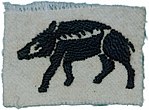| Hampshire County Division | |
|---|---|
 Division insignia of the Hampshire County Division | |
| Active | 28 February 1941—31 December 1941 |
| Country |
|
| Branch |
|
| Type | Static Defence Division |
| Role | Home Defence |
| Size | Division |
| Part of | V Corps |
| Division HQ | Raglan Barracks, Devonport |
| Commanders | |
| Current commander | Major General George James Paul St. Clair |
The Hampshire County Division was a formation of the British Army, raised in World War II and originally formed on 28 February 1941 by the redesignation of Hampshire Area.
History[]
On 28 February 1941, the Hampshire County Division was formed through the redesignation of the short-lived Hampshire Area, itself formed from the splitting of Southern Area.[1]
After formation, the new division was suborinated to V Corps, which was tasked with covering the coast in the counties of the old Southern Area: Dorset, Wiltshire (except that portion of the county included in the Salisbury Plain Area), and Hampshire (except those portions of the country included in the Aldershot Command, the Salisbury Plain Area and the Portsmouth Area).[1][2][3]
The division's one and only commander was Major General George James Paul St. Clair, who held the post from 28 February 1941 to 31 November 1941.[4][5]
Disbandment[]
On 22 June 1941, Germany launched a massive attack upon the Soviet Union; this attack all but removed the threat of a German invasion of the United Kingdom. However, the British still had to consider the threat due to the possibility that the Soviet Union could collapse under the German onslaught and the ease in which Germany could transfer troops back to the west. In late 1941, the arrival of autumn and winter weather meant that the threat of invasion subsided. This, coupled with the production of new equipment for the British Army, allowed the War Office to begin steps to better balance the army due to the large number of infantry units formed during the preceding year and a half. As part of this reform, the County Divisions were disbanded.
Therefore, on 25 November 1941 the division ceased to function, and on 31 December 1941, the Hampshire Division was disbanded and its tasked subsumed by HQ Southern Area.[5]
Organisation[]

Private of the 12th Battalion, Hampshire Regiment in training at Hengistbury Head near Bournemouth, Dorset. Wearing his gas mask, a soldier advances through a smoke screen.
The division's organisation was as follows.[5]
- Division Headquarters, at Raglan Barracks, Devonport
- 3 Sub-Areas
- 214th Independent Infantry Brigade (Home)—attached from 28 February to 20 November 1941[6]
- Brigade Headquarters, at The Keep, Dorchester (at No.14 Infantry Training Group)[7]
- 11th Battalion, The West Yorkshire Regiment (The Prince of Wales's Own)
- 11th (Royal Militia of the Island of Jersey) Battalion, The Hampshire Regiment
- 12th Battalion, The Hampshire Regiment
- 7th Battalion, The Wiltshire Regiment (Duke of Edinburgh's Own)
Division badge history[]
The badge is a reference to the famous "Hog's back" geographical feature in Hampshire. Cole claims that the badge appears on both rectangular and semi-circular grounds. The Division was formed 28 February 1941 by redesignation of Hampshire Area. It comprised only one Infantry Brigade (214 Independent (Home)) but in addition had three Sub-Areas. The Division ceased to function 25 November and was disbanded 31 December 1941.[8]
See also[]
Footnotes[]
- ↑ 1.0 1.1 Pettibone, p. 186.
- ↑ "Southern Area, Southern Command, 03.09.1939". http://niehorster.org/017_britain/39_commands/southern_southern__staff.htm.
- ↑ Collier, Disposition of Home Force 11 September 1940.
- ↑ "Biography of Major-General George James Paul St. Clair (1885 – 1955), Great Britain". https://www.generals.dk/general/St._Clair/George_James_Paul/Great_Britain.html.
- ↑ 5.0 5.1 5.2 Joslen, p. 112
- ↑ Joslen, p. 376.
- ↑ Frederick, p. 115.
- ↑ "badge, formation, Hampshire County Division." (in en). https://www.iwm.org.uk/collections/item/object/30072490.
References[]
- Cole, Howard (1973). Formation Badges of World War 2 Britain, Commonwealth and Empire. London: Arms and Armour Press.
- Frederick, J. B. M. (1984). Lineage book of British land forces 1660-1978 : biographical outlines of cavalry, yeomanry, armour, artillery, infantry, marines and air force land troops of regular and reserve forces (Volume I). Wakefield: Microform Academic. ISBN 978-1-85117-007-4. OCLC 18072764.
- H. F. Joslen, Orders of Battle; Second World War 1939-1945, Reprinted in Middletown, Delaware by Permission of Her Majesty's Stationery Office, London, United Kingdom, (1960 edition), 2009, (re-printed, 2019). ISBN 978-1-84176-052-0.
- Charles D. Pettibone, The Organization and Order of Battle of Militaries in World War II, Volume II - The British Commonwealth, Trafford Publishing, Victoria, Canada/Rochester, United States. 2006. ISBN 1-4120-8567-5.
- Colin Basil, Official History of the Second World War Series; The Defence of the United Kingdom, 1957: Her Majesty's Stationery Office, London.
The original article can be found at Hampshire County Division and the edit history here.